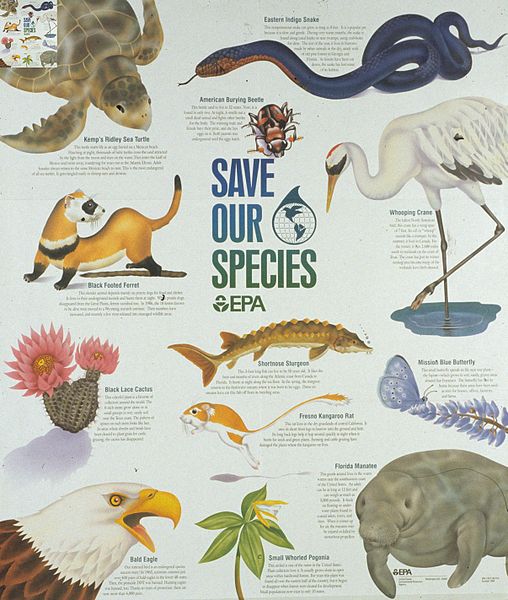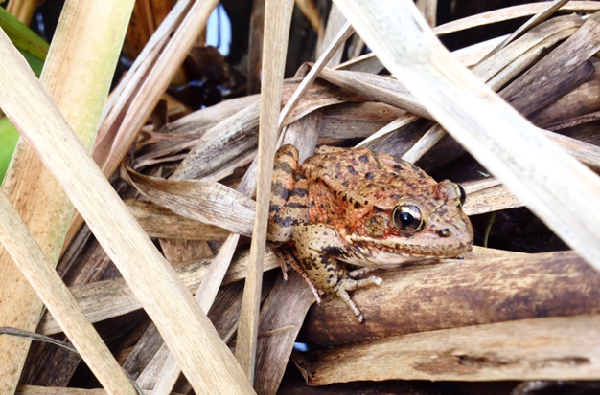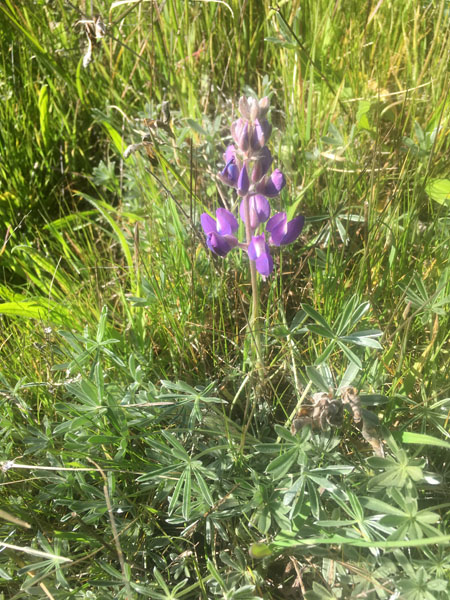|
Let’s Learn About Endangered Species!
Marin Park Stewardship's April 2017 Newsletter
|
Dear Friend,
April has arrived, and we have officially completed our planting season with the help of some winter rains—and lots of awesome volunteers! We are moving into the month of April, when the Parks Conservancy will host many fun Earth Day events! You can find more info on Earth Day—and Earth Week—in the parks in this newsletter. You’ll also learn about the Endangered Species Act and how it applies to wildlife in our national parks.
In This Newsletter
Earth Day Events
Saturday, April 22 is Earth Day! If you are looking for ways to get involved with helping our planet, there are many events going on in our parks throughout the whole week, from April 22- April 29. Come celebrate Earth Day with us as we work together to learn more about, and protect the health of the diverse ecosystems that surround us!
Saturday, April 22:
- Mt. Tam Earth Day
- Join the One Tam team at the Mountain Theater atop lovely Mt. Tamalpais for a morning of service projects. We will be pulling invasive plants that threaten the mountain’s biodiversity, improving the mountain’s trails, and working to maintain the historic Mountain Theater
- Location: Mountain Theater
- Time: 9:30 am-12:20 pm
- Rodeo Beach Cleanup
- Join us in scenic Rodeo Valley for a beach and park cleanup. Stay the afternoon for a picnic, hike the trails, and visit nearby historic sites
- Location: Rodeo Beach in the Marin Headlandso Family friendly; all ages are welcome!
- Time: 10am-1pm
Sunday, April 23
- Stinson Beach Cleanup
- Care for the coast and create art at the Create-With-Nature Earth Day Celebration. Family friendly, all ages welcome
- Location: Stinson Beach
- Time: 11 am-2 pm
To register for Earth Week events and for more information on events through April 29, please visit: http://www.parksconservancy.org/events/volunteer-events/special-events/earth-week.html
Thank you for your efforts in keeping our Earth healthy! See you there.
A Brief History of the Endangered Species Act
By Rebecca Natoli
|
Key Vocabulary (Definitions from the U.S. Fish and Wildlife Service)
- Threatened species: A plant or animal that is likely to become endangered in the foreseeable future throughout all or a significant portion of its range
- Endangered species: A plant or animal that is in danger of extinction throughout all or a significant portion of its range
- Take: To harass, harm, pursue, hunt, shoot, wound, kill, trap, capture, or collect or attempt to engage in any such conduct
- Critical habitat: Geographic areas that contain the physical or biological features that are essential to the conservation of the species and that may need special management or protection
|
Since moving to California, I had wondered why there is a grizzly bear on California’s state flag, because they are not found here in the state. I investigated, and learned that before Euro-American settlers arrived in California in the mid-1800s, California grizzly populations had in fact flourished throughout the state.
However, grizzly bear populations were extirpated from California by the early 1920s due to overhunting and habitat loss as the state's human population grew. The California grizzly bear is one of many examples of tragic and often-irreversible consequences that can arise from an imbalanced ecosystem.
What is the Endangered Species Act?
In the 1960s and 70s, the impact humans were having on the environment, and the need to protect it, were becoming more and more evident. In 1962 Rachel Carson published her book Silent Spring portraying the devastating effects of DDT and pesticides can have on wildlife and the human population.
In 1970 the first Earth Day took place, the Clean Air Act was passed, and President Nixon established the Environmental Protection Agency (EPA). In 1972 the Clean Water Act was passed to address the growing concern over water pollution in the country.
Community members, scientists, and political leaders alike began to understand that wildlife protection had to go beyond focusing on fish and waterfowl for hunting and fishing. They came to understand that humans from all different backgrounds benefit and depend upon the natural resources our wildlands provide.
Therefore, the health of our ecosystems and the quality of life on Earth as a whole needed to be addressed, and the best way to understand the health of our ecosystems was through the status of the different species that inhabited them.

|
Photo by USEPA /Wikimedia Commons
|
During the cascade of environmental legislation passed during this period, often referred to as the Environmental Movement, in 1973 Congress passed arguably the most important piece of legislation in history for the protection of wildlife species and wildlands: the Endangered Species Act (ESA).
For almost 45 years, the ESA has provided an imperative framework for the conservation of threatened and endangered animals and plants, as well as their habitats. This law prohibits the “take”, or harm, of any listed threatened or endangered species, as well as any activity authorized, funded, or carried out by federal agencies that would “jeopardize a listed species or destroy or modify its critical habitat.”
The primary agencies that implement and enforce this law include the U.S. Fish and Wildlife Service (FWS) and the National Marine Fisheries Service (NMFS) within the U.S. National Oceanic and Atmospheric Administration (NOAA). The ESA requires federal agencies and the people to consider the impact their actions will have on listed species, follow appropriate steps to ensure that they do not harm any listed species, and hold those who do not comply legally accountable for their actions.
How does a species qualify for protection under the Endangered Species Act?
The first step, according to the FWS, is that a plant or animal species must be added to a precursory Federal list of endangered and threatened wildlife or plants, prior to making it on the actual ESA list. Scientists, policy makers, and managers within FWS and NMFS determine what species are at the highest risk and in need of federal protection.After being listed on these Federal lists, a species can be added to the ESA through two possible regulatory procedures:
- The Petition Process: The petition process allows anyone to petition the Secretary of the Department of the Interior (for terrestrial species) or Secretary of Commerce (for marine species) to add or remove a species from the list.
- Candidate Assessment Process: Biologists within the FWS and NMFS conduct a thorough assessment of the status of a species and identify species, or “candidates,” from the Federal lists. The information used to make the assessment may come from a variety of sources, including scientific literature, federal agencies, state fish and wildlife agencies, universities, and tribes. The species are assigned a priority value based on the magnitude of its precarious status. A decision is ultimately made based on the following criteria:
- Threat of habitat destruction
- Threat of overexploitation
- Threat of disease or predation
- Insufficient “regulatory mechanisms”
- Other imperative natural or manmade factors threatening a species’ or population’s survival
Why is the ESA important?

|
The threatened California Red-legged Frog. Photo by Parks Conservancy Park Stewardship
|
Once a species is listed under the ESA, one of the most important conservation steps taken for that species is the designation of critical habitat, and the protection of that critical habitat from destruction or detrimental changes. Not only does the ESA prevent activities that may jeopardize a listed species, it directs and allows federal agencies (like the National Park Service) to actively conduct conservation and recovery programs to help threatened and endangered populations. It also requires that any individual have a permit to perform a take of a listed species.
Being on the ESA also promotes the conservation status of animals and plants to a broad public audience, therefore encouraging more education and protection surrounding endangered and threatened species. As populations become endangered, the role that those endangered organisms played within their ecosystem becomes limited or could disappear altogether, which can cause an imbalance and threaten the health of the overall ecosystem.
In the last couple decades, a new stressor, climate change, has emerged as one of the most significant threats to biodiversity on our planet. How will our ecosystems respond? That is an ongoing question we are trying to answer. Climate change will impact the natural integrity of ecosystems, and endangered species will be the most vulnerable to these changes.
To learn more about threatened and endangered species, you can visit https://www.fws.gov/endangered/; to learn more about the ESA in detail, you can visit https://www.fws.gov/endangered/laws-policies/esa-history.html
To see the Worldwide List of Endangered Species, please visit https://www.fws.gov/endangered/species/index.html
Endangered Species in our National Parks
How many rare, threatened, and endangered species do you think you can you find in the Golden Gate National Parks? Ten? Twenty? Try 35.

|
A
flowering lupine plant found in endangered mission blue butterfly habitat in the Marin Headands.
Photo by Rachel Stump.
|
Golden Gate is home to the greatest number of federally protected species in any national park within the contiguous United States—more than can be found in Yosemite, Yellowstone, Sequoia, and Kings Canyon National Parks combined!
National parks play an important role in conservation efforts for endangered species. They provide large regions of contiguous habitat, free from human development and exploitation. The National Park Service also conducts research and monitoring to better understand, protect, and restore endangered and threatened populations and their critical habitat. NPS also works with partner agencies to recognize and manage conservation strategies for species that may become susceptible to endangerment.
Restoration projects, like planting lupines for mission blue butterfly habitat or helping to improve the Redwood Creek Watershed for the coho salmon, are just some examples of the many ways that volunteers like you can get involved in the conservation of endangered species in our park!
Please visit http://www.sfnps.org/endangered to learn more about the amazing rare, threatened, and endangered species you can find right here in the Golden Gate National Parks.
Restoration Is Working
Check out this awesome video about the progress and ongoing restoration of Muir Beach–one of our work sites–by San Francisco Bay Joint Venture.
http://www.sfbayjv.org/
Thanks to all the volunteers who have given their time to make Muir Beach what it is today. We invite you to continue to help us restore this habitat at our Volunteer Work Days.
Kat’s Studying Cattails
By Kathryn Tisshaw
I am happy to announce that in May I will be pursuing a Master’s degree in Environmental and Life Sciences at Trent University in Peterborough, Ontario, Canada.
My project involves comparing two geographically distinct populations of cattails in the Great Lakes Area and East in Nova Scotia and Maine. For some reason the non-native cattail, the native cattail, and their hybrid all occur in both regions, but only the hybrid is invasive in the Great Lakes. It invades wetlands and eliminates the possibility for any other plant species to establish. I will be trying to answer why the hybrid only invades the Great Lakes by looking at human disturbance regimes, soil nutrients, and fertility across the Great Lakes and Eastern populations.
I will also be setting up a common-garden competition experiment and growing cattails in a greenhouse. I will collect the seeds from the two geographically distinct locations to see if the hybrid from the Great Lakes is more superior and can outcompete the non-native and native cattail parents. “Common-garden” means that I’ll be growing my plants in a greenhouse where they will have access to the same amounts of nutrients, water, and light. This way I can conclude that competition is what’s driving differences in growth, and rule out resource availability as a factor. This summer, I will be doing some field work in Nova Scotia and setting up the common-garden competition experiment.
Understanding the conditions and biological processes that promote non-native plant invasions will aid in predicting future bioinvasions and ultimately how we manage and preserve our ecosystems to prevent these invasions. The restoration work I have done for the Golden Gate Parks Conservancy has inspired me to continue to study these topics and hopefully get a job as a restoration ecologist. I am excited for this new opportunity but also very sad to leave my Conservancy family.
Post-Winter Counts in Marin
Planting Progress
We’ve finished the planting season!
Muir Beach: 1,780
Alta Avenue: 670
Wolfback Ridge: 150 lupines
California Red-legged Frog Monitoring
Total number of new egg masses found this season:
Muir Beach: 56
Banducci: 68
Marin Volunteer Program Information and Work Day Schedules
Marin Park
Stewardship
Saturdays, 10 am–1 pm, and Wednesdays, 1–4 pm
We alternate between sites, so check the details for each work day. Work day events include a combination of hands-on service and short natural or cultural history lessons.
Click here to
learn more or sign up.
Wednesday program sites:
April 5: Alta Avenue
April 12: Muir Beach
April 19: Alta Avenue
April 26: Muir Beach
May 3: Alta Avenue
May 10: Muir Beach
May 17: Wolfback Ridge
May 24: Muir Beach
May 31: No Program
Saturday program sites:
April 8: Muir Beach
April 15: No Program
April 22: One Tam Earth Day
April 29: No Program
May 6: Alta Avenue
May 13: Muir Beach
May 20: Oakwood Valley
May 27: No Program
Meeting Locations and
Directions
Muir Beach – Meet
at the parking lot picnic tables. Map
Alta Avenue at Oakwood Valley – Meet at the park gate located at the end of
Donahue Street. Map
Wolfback Ridge – Take
a right on Bunker Road (immediately before the tunnel). Park in the lot by the
bus shelter behind the Marin Headlands sign, only in a designated parking spot
(not along the road). We will meet in the parking lot. Map
Marin Headlands Nursery
Wednesdays, 1–4 pm
1st and 3rd Tuesday of every month, 10 am–2 pm
Come grow with us at the Marin Headlands Nursery! Each year, we grow over 30,000 plants to restore natural habitats within the Marin Headlands. The dedication and support of our volunteers are vital in the effort to grow plants, collect seeds, maintain the nursery facility, and much more. Our projects are outdoors, fun, and always hands-on.
For program updates and registration, click here.
Habitat Restoration Team
2nd and 4th Tuesdays, 10 am–2 pm
Sundays at 9:30 am–2:30 pm
Help restore and monitor critical natural areas from the Marin Headlands to Bolinas Ridge. Volunteers and staff meet at different scenic locations each week to restore native habitat throughout the Golden Gate National Parks. Come out and explore beautiful areas while assisting in invasive plant removal, winter planting, and seed collection. For more information,
click here.
Invasive Plant
Patrol
Wednesdays, 10 am–2:30 pm
An ounce of prevention is worth a pound of cure. Invasive Plant Patrol volunteers hike throughout the Marin Headlands to find new invasions of exotics and remove localized infestations before they get out of control. Get to know the park trail systems and learn to identify plants, both native and invasive. Hikes will last approximately four hours. Locations vary from the Marin Headlands to Bolinas Ridge. For locations and to register, click
here.

|
A big thank you to Strava for coming out to Oakwood Valley and pulling 26,000 French broom!
Photo by Maria Durana
|
Thank you for supporting the Golden Gate National Parks Conservancy!
-Marin Park Stewardship

|